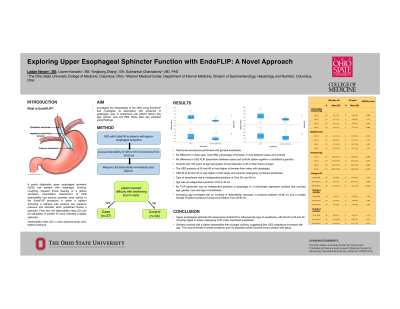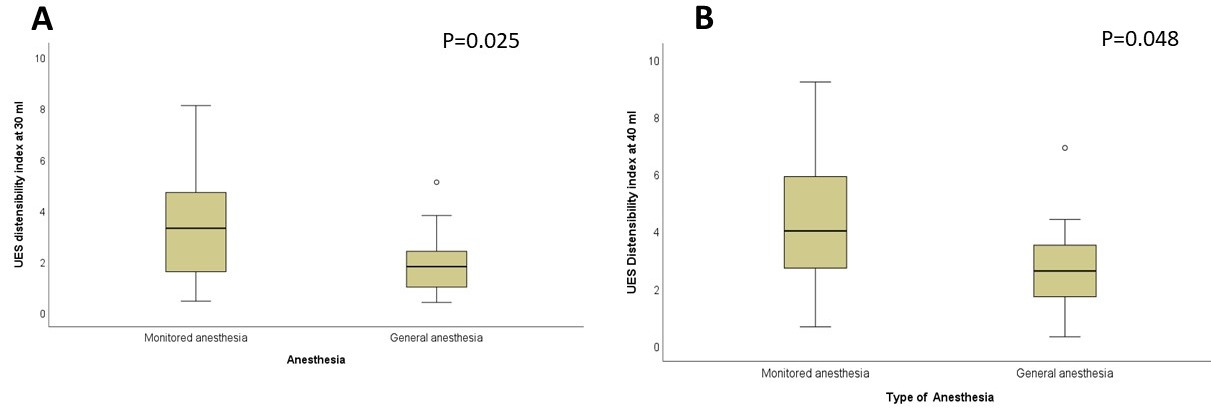Tuesday Poster Session
Category: Esophagus
P3253 - Exploring Upper Esophageal Sphincter Function With EndoFLIP: A Novel Approach
Tuesday, October 24, 2023
10:30 AM - 4:00 PM PT
Location: Exhibit Hall

Has Audio

Ladan Navari, BS
The Ohio State University College of Medicine
Columbus, OH
Presenting Author(s)
Ladan Navari, BS1, Yongkang Zhang, MD2, Lauren Kanzaki, MS3, Subhankar Chakraborty, MD, PhD3
1The Ohio State University College of Medicine, Columbus, OH; 2Ohio State University Wexner Medical Center, Columbus, OH; 3The Ohio State University, Columbus, OH
Introduction: The upper esophageal sphincter (UES) plays a vital role in the process of swallowing and preventing aspiration. EndoFLIP is a technique that allows real-time evaluation of the mechanical properties of esophageal sphincters. We sought to investigate the distensibility of the UES using EndoFLIP and its association with dysphagia, anesthesia and patient factors.
Methods: UES distensibility index (DI), diameter and pressure were measured in patients undergoing EndoFLIP during upper endoscopy for gastroesophageal symptoms. The EF-322 catheter was positioned across the UES and inflated to a volume of 30 ml followed by inflation in 10 ml increments every 30 seconds upto 60 ml. Patients were classified them as "cases" (with dysphagia) or "controls" (no dysphagia). One-way ANOVA was used to compare FLIP parameters between cases and controls. Multi-variate regression was used to assess whether a factor was an independent predictor of dysphagia or UES FLIP parameters. A receiver operating characteristic was used to assess whether an optimum cut-off could distinguish cases from controls.
Results: There were 37 cases and 34 controls. Twenty-two procedures were performed with general anesthesia and the rest under monitored anesthesia (MAC).There was no difference in mean age, BMI, percentage of females, white or black patients between cases and controls. There was no difference in UES FLIP parameters between cases and controls whether taken together or stratified by gender. Among controls, geriatric patients (65 years and older) had greater DI and diameter at 40 ml than those younger (Table 1). UES pressure at 50 and 60 ml was higher in females than males with dysphagia. UES DI at 30 and 40 ml was higher in both cases and controls undergoing MAC (Figure 1). Type of anesthesia was an independent predictor of DI at 30 and 40-ml. Age was an independent predictor of DI at 40 ml. No FLIP parameter was an independent predictor of dysphagia in a multivariate analysis that included age, gender, race and type of anesthesia. Increasing age correlated with an increase in UES distensibility, decrease in intra-balloon pressure between 40-60 ml and with a smaller change in balloon pressure during serial inflation from 30-60 ml.
Discussion: UES DI is lower with MAC at 30 and 40 ml, possibly due to endotracheal tube affecting distensibility in those undergoing general anesthesia. Geriatric controls had a higher DI which may explain why certain problems like aspiration are more common with ageing.

Disclosures:
Ladan Navari, BS1, Yongkang Zhang, MD2, Lauren Kanzaki, MS3, Subhankar Chakraborty, MD, PhD3. P3253 - Exploring Upper Esophageal Sphincter Function With EndoFLIP: A Novel Approach, ACG 2023 Annual Scientific Meeting Abstracts. Vancouver, BC, Canada: American College of Gastroenterology.
1The Ohio State University College of Medicine, Columbus, OH; 2Ohio State University Wexner Medical Center, Columbus, OH; 3The Ohio State University, Columbus, OH
Introduction: The upper esophageal sphincter (UES) plays a vital role in the process of swallowing and preventing aspiration. EndoFLIP is a technique that allows real-time evaluation of the mechanical properties of esophageal sphincters. We sought to investigate the distensibility of the UES using EndoFLIP and its association with dysphagia, anesthesia and patient factors.
Methods: UES distensibility index (DI), diameter and pressure were measured in patients undergoing EndoFLIP during upper endoscopy for gastroesophageal symptoms. The EF-322 catheter was positioned across the UES and inflated to a volume of 30 ml followed by inflation in 10 ml increments every 30 seconds upto 60 ml. Patients were classified them as "cases" (with dysphagia) or "controls" (no dysphagia). One-way ANOVA was used to compare FLIP parameters between cases and controls. Multi-variate regression was used to assess whether a factor was an independent predictor of dysphagia or UES FLIP parameters. A receiver operating characteristic was used to assess whether an optimum cut-off could distinguish cases from controls.
Results: There were 37 cases and 34 controls. Twenty-two procedures were performed with general anesthesia and the rest under monitored anesthesia (MAC).There was no difference in mean age, BMI, percentage of females, white or black patients between cases and controls. There was no difference in UES FLIP parameters between cases and controls whether taken together or stratified by gender. Among controls, geriatric patients (65 years and older) had greater DI and diameter at 40 ml than those younger (Table 1). UES pressure at 50 and 60 ml was higher in females than males with dysphagia. UES DI at 30 and 40 ml was higher in both cases and controls undergoing MAC (Figure 1). Type of anesthesia was an independent predictor of DI at 30 and 40-ml. Age was an independent predictor of DI at 40 ml. No FLIP parameter was an independent predictor of dysphagia in a multivariate analysis that included age, gender, race and type of anesthesia. Increasing age correlated with an increase in UES distensibility, decrease in intra-balloon pressure between 40-60 ml and with a smaller change in balloon pressure during serial inflation from 30-60 ml.
Discussion: UES DI is lower with MAC at 30 and 40 ml, possibly due to endotracheal tube affecting distensibility in those undergoing general anesthesia. Geriatric controls had a higher DI which may explain why certain problems like aspiration are more common with ageing.

Figure: Figure 1. Box plot comparing Upper esophageal sphincter (UES) distensibility index (DI) in patients without dysphagia with Monitored anesthesia and general anesthesia. The p-value corresponds to one-way ANOVA test. Panel A- UES DI at 30 ml, B- UES DI at 40 ml
Disclosures:
Ladan Navari indicated no relevant financial relationships.
Yongkang Zhang indicated no relevant financial relationships.
Lauren Kanzaki indicated no relevant financial relationships.
Subhankar Chakraborty: Coloplast – Consultant. Medtronic – Consultant.
Ladan Navari, BS1, Yongkang Zhang, MD2, Lauren Kanzaki, MS3, Subhankar Chakraborty, MD, PhD3. P3253 - Exploring Upper Esophageal Sphincter Function With EndoFLIP: A Novel Approach, ACG 2023 Annual Scientific Meeting Abstracts. Vancouver, BC, Canada: American College of Gastroenterology.
